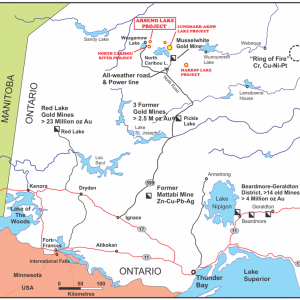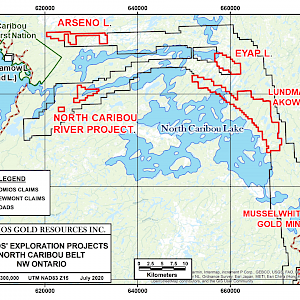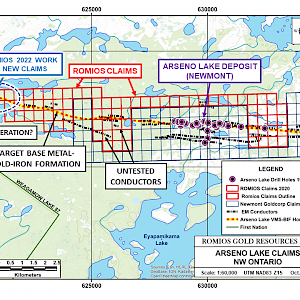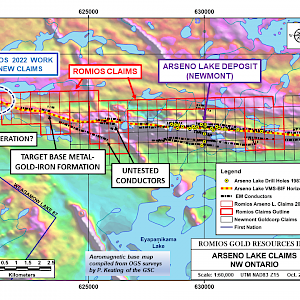Arseno Lake
-
Overview
Property Type• Bathurst-type Base Metal Sulphide Zone within Banded Iron Formation
Size• 1654 Hectares, 86 single cell mining claims
Status• 100% owned by Romios Gold Resources Inc.
• 2% NSR held by Bounty Gold Corp. on 140 calims.
Exploration Stage
• Grass-roots project along strike from the nearby Arseno Lake Pb-Zn-Ag+/- Au deposit now held by Newmont.
Location
• 525 km north of the city of Thunder Bay and 178 km north of the town of Pickle Lake in NW Ontario.
• 8 km NE of the road accessible North Caribou Lake First Nations community of Round Lake (a.k.a. Weagamow Lake).
-
Geology/Exploration
Highlights of Key Target Areas
The unusual Arseno Lake Pb-Zn-Ag+/-Au occurrence now owned by Newmont was originally explored by Northern Dynasty in the mid-1980’s through mapping, surface sampling and diamond drilling (18 holes). They outlined a main zone approx. 1.3 km long containing ~920,000 tonnes grading 8.7% Zn+Pb and 1.5 oz/t Ag. Mineralization consists of galena, sphalerite, pyrite, pyrrhotite and arsenopyrite in massive and semi-massive bands as well as diffuse, wispy anastomosing stringer zones within quartz-grunerite iron formation. This is often enveloped in biotite-chlorite-garnet schist and overprinted by a 700 m wide ductile shear zone with local green mica alteration, tourmaline veining and sporadic gold mineralization. Little work of any consequence has been done on the property since the late 1980s. Numerous EM conductors along strike from the main zone have never been drilled, including a cluster of conductors west of the main zone on Romios’ claims.
Romios’ Arseno Lake claims flank Newmont’s Arseno Lake deposit claims to the west and east, along the strike of the host iron formation and associated EM conductors. The western claims host a 1.3 km long cluster of conductors flanking the Newmont claims and several longer conductors extending a further 3 km west. These conductors trend towards a series of poorly exposed metasedimentary schists containing unusually prominent coarse biotite grains and a variety of kyanite, andalusite and staurolite porphyroblasts. This assemblage may be indicative of hydrothermal alteration typically associated with VMS deposits. Romios collected samples of these schists in June 2022, and it is expected that the lithogeochemical analyses will indicate whether they are hydrothermal in origin or not. If the analyses indicate the schists represent a metamorphosed alteration pathway, then the EM conductors nearby will become even higher-priority targets.
-
Press Releases
Jun 20, 2022Feb 8, 2022Jun 16, 2021




